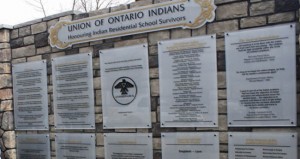Reconciliation: changing what we say about each other
April 24, 2014

By Murray Sinclair
Special to CBC News
Now that the Truth and Reconciliation Commission’s seventh and final national event is over, some have asked, “What’s next?”
From the perspective of the commission, while our major public events are over, the mandate of the commission is not. The most significant item remaining has to do with reconciliation — and developing a process that engages aboriginal and non-aboriginal people in that dialogue, not just for the remaining year but on into the future as well.
The commissioners have constantly reminded people that the achievement of reconciliation, however one defines it, within the lifetime of the commission was not a realistic ambition.
The commissioners have constantly reminded people that the achievement of reconciliation, however one defines it, within the lifetime of the commission was not a realistic ambition.
We have pointed out that Indian residential schools were around for over 100 years, and that several generations of children went through the schools during their time. The damage that the schools inflicted on their lives and the lives of the members of their families and communities will take also generations to fix.

The loss of language and culture, the impacts on family function, the devastation to self-identity, the loss of respect for education, and the loss of faith and trust in Canada’s government will take many years to overcome, and will only be achieved with a focus on a vision for a new relationship and a commitment to behavioural change and positive action.
Engaging Canada in a commitment to that change will require Canadians to see and accept that this is not an aboriginal problem but is a Canadian one — partially because Canada has a reputation that needs fixing, but also because all Canadians have been taught to believe in the negative stereotypes of Canada’s indigenous people in our public schools, and that long term racism needs to be brought to a halt.
A commitment to change will also call upon Canadians to realize that reconciliation is not a new opportunity to convince aboriginal people to “get over it” and become like “everyone else.” That is, after all, what residential schools were all about and look how that went.
It is an opportunity for everyone to see that change is needed on both sides and that common ground must be found. We are, after all, talking about forging a new relationship, and both sides have to have a say in how that relationship develops or it isn’t going to be new.
Canada’s unilateral use of law to define and limit that relationship is a vessel that can no longer hold water, so a discussion between equals must occur.
However, in addition to the grand dialogue about reconciliation that such an approach will entail, we also have to talk about reconciliation at the personal, and family and community level. That is where true change will occur, for it is in our daily lives where we seek and, hopefully, find peace.
Our leaders need to show the way, but no matter how many deals and agreements they make, it is in our daily conversations and interactions that our success as a nation in forging a better place, will ultimately be measured. It is what we say to and about each other in public and in private that we need to look at changing.
We’re not going to change all that in the next year, but we plan on doing what we can to make people think about it.
Because, when this commission ends, it’s going to be all up to you.
We’re not going to change all that in the next year, but we plan on doing what we can to make people think about it.
Because, when this commission ends, it’s going to be all up to you.
The Honourable Justice Murray Sinclair is the chair of The Truth and Reconciliation Commission of Canada.

